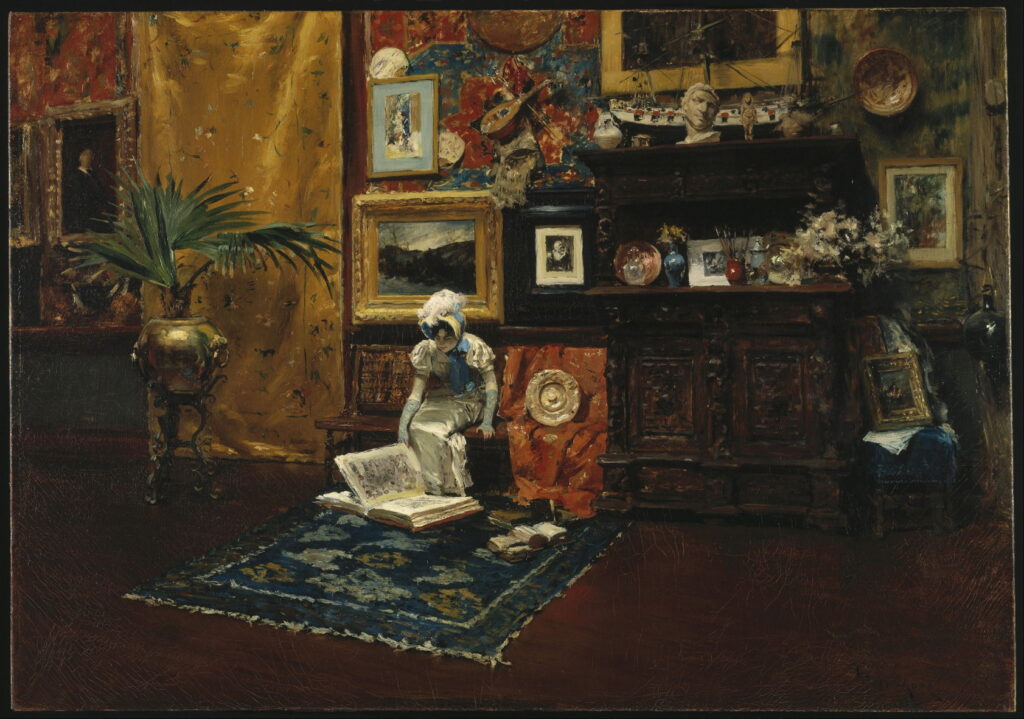Interiors by Design: Carpets

Although of ancient origin, in Europe the idea of laying carpet on the floor is surprisingly recent. Woven and backed textiles resembling modern carpets appear to have originated in the Caucasian area and in Anatolia, and first made their way to western Europe with the Crusades. It was another seven centuries before Europeans realised they weren’t only intended to be hung from walls or placed on tables. Their wider adoption as floor coverings may have been limited by the difficulties in cleaning by beating them outdoors.
Jean-Léon Gérôme (1824–1904), The Carpet Merchant (of Cairo) (1887), oil on canvas, 83.4 x 64.7 cm, Minneapolis Institute of Art, Minneapolis, MN. Wikimedia Commons.
Jean-Léon Gérôme’s Carpet Merchant (of Cairo) from 1887 shows a contemporary trading scene in almost photographic detail. Standing on and among crumpled up carpets in this corner of a souk is a group of traders and their customers, admiring one particularly fine example hanging from a balcony as they haggle over price. As an image within an image, Gérôme paints the calligraphic design of the carpet in painstaking detail.
Georges Rochegrosse (1859–1938), The Palace Entertainment (date not known), oil on canvas, further details not known. The Athenaeum.
You could easily mistake Georges Rochegrosse’s undated Palace Entertainment for another by his contemporary Gérôme, although by this time (the period 1894-1914) Rochegrosse was often far more painterly in his style. It shows a dancer with musical group entertaining some Algerian men, her routine involving a pair of short swords. Under her feet is a large and brilliant scarlet carpet.
Osman Hamdi Bey (1842–1910), Kur’an Tilaveti (Reciting the Quran) (1910), oil, 53 x 72.5 cm, Sakıp Sabancı Museum, Istanbul, Turkey. Wikimedia Commons.
Carpets were also in widespread use as floor coverings throughout Turkey and the Middle East, as shown in Osman Hamdi Bey’s painting of Reciting the Quran from 1910. At its foot is a wonderful deep blue carpet.
Philip Hermogenes Calderon (1833–1898), “Lord, Thy Will Be Done” (1855), oil on canvas, 55.9 x 46.4 cm, The Yale Center for British Art, New Haven, CT. Wikimedia Commons.
In Philip Hermogenes Calderon’s “Lord, Thy Will Be Done” from 1855, the small and threadbare piece of carpet tells you more about this young mother’s financial and social status than any other object in the room.
Among the early depictions of floor carpets is James Abbott McNeill Whistler’s chinoiserie interior painted in 1863-65, which might give rise to geographical confusion.
James Abbott McNeill Whistler (1834–1903), The Princess from the Land of Porcelain (1863-65), oil on canvas, 201.5 x 116.1 cm, Freer Gallery of Art, Smithsonian Institution, Washington, DC. Wikimedia Commons.
Whistler’s The Princess from the Land of Porcelain (1863-65), from his Peacock Room, is shown above and in the detail below. The model’s features are European rather than Oriental (she was actually from an Italian family), but she’s wearing a fine silk kimono and holding a fan. Behind her is a painted screen from Japan, and under her feet is a lush white and blue carpet.
This is the painting at the focal point of the lavish dining room of the London house of Frederick Richards Leyland, a shipping magnate. Whistler and Leyland fell out over changes the artist made to the original design, and Whistler was forced into bankruptcy as a result. The contents of the room were purchased in 1904, moved to the USA, and exhibited in the Freer Gallery in Washington, DC, from 1923.
James Abbott McNeill Whistler (1834–1903), The Princess from the Land of Porcelain (detail) (1863-65), oil on canvas, dimensions not known, Freer Gallery of Art, Smithsonian Institution, Washington, DC. Wikimedia Commons.
Giovanni Boldini (1842–1931), Peaceful Days (The Music Lesson) (1875), oil on canvas, 35.5 × 25.4 cm, Sterling and Francine Clark Art Institute, Williamstown, MA. Wikimedia Commons.
In Giovanni Boldini’s Peaceful Days (The Music Lesson) from 1875, a younger boy sits on a vividly decorated carpet studying an epée, with a cello behind him. Judging by their dress and surroundings, these two are at least comfortably off, and certainly well-carpeted.
John William Waterhouse (1849–1917), Dolce Far Niente (The White Feather Fan) (1879), oil on canvas, 49.6 x 36.2 cm, Private collection. Wikimedia Commons.
There’s also something indulgent and sensuous about lying back on an exotic carpet, in the way that this woman is in John William Waterhouse’s Dolce Far Niente or The White Feather Fan (1879). She’s plucking feathers from the fan and watching them rise through the air, a perfect way to while away the time, it seems.
William Merritt Chase (1849–1916), Studio Interior (c 1882), oil on canvas, 71.3 x 101.9 cm, Brooklyn Museum, New York, NY. Wikimedia Commons.
William Merritt Chase’s paintings of his studio acted as a shop window for prospective customers. In his Studio Interior from about 1882, a fashionably dressed young woman is glancing through a huge bound collation of Chase’s work, sat by a grand carved wooden sideboard, decorated with almost outlandish objects including a model ship, a lute, and sundry objets d’art. Under her feet is a wonderful blue carpet, no doubt ready to transport her into the scenes shown in Chase’s book.
Félix Vallotton (1865–1925), Interior, Bedroom with Two Figures (1904), oil on cardboard, 61.5 × 56 cm, Hermitage Museum Государственный Эрмитаж, Saint Petersburg, Russia. Wikimedia Commons.
By the turn of the century, and Félix Vallotton’s disturbing domestic scenes such as Interior, Bedroom with Two Figures (1904), the prosperous were having wall-to-wall carpets fitted in their houses. The lady of the house is standing on a patterned carpet that runs under the bed, and at the left extends to the wall.
Colours and patterns soon became vibrant if not gaudy.
Pierre Bonnard (1867-1947), Nude in Bathtub (c 1938-41), oil on canvas, 121.9 x 151.1 cm, Carnegie Museum of Art, Pittsburgh, PA. The Athenaeum.
In Pierre Bonnard’s Nude in Bathtub from about 1938-41, the flooring dazzles, and Marthe’s brown dog has its own mat.
Eric Ravilious (1903–1942), Farmhouse Bedroom (1939), watercolour, further details not known. Wikimedia Commons.
Eric Ravilious’ Farmhouse Bedroom (1939) overwhelms the viewer with the patterns in its flooring that contradict rather than complement its walls.

